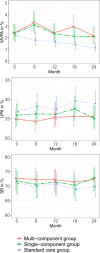Relative time in physical activity and sedentary behaviour across a 2-year pedometer-based intervention in people with prediabetes or type 2 diabetes: a secondary analysis of a randomised controlled trial
- PMID: 40217375
- PMCID: PMC11960371
- DOI: 10.1186/s44167-023-00020-w
Relative time in physical activity and sedentary behaviour across a 2-year pedometer-based intervention in people with prediabetes or type 2 diabetes: a secondary analysis of a randomised controlled trial
Abstract
Background: People with prediabetes or type 2 diabetes (T2D) need to be physically active, including moderate-to-vigorous intensity physical activity (MVPA) and light-intensity physical activity (LIPA) and reduce time in sedentary behaviour (SB). Few studies have evaluated the effect of randomised controlled trials taking all movement behaviours into account. This study aimed to investigate the effects of a 2-year pedometer-based intervention in people with prediabetes or T2D on relative time in movement behaviours.
Methods: Secondary analysis of longitudinal data on individuals with prediabetes or T2D from a three-armed randomised controlled trial, the Sophia Step Study, was conducted. The three groups were (1) a multi‑component group (self‑monitoring of steps with a pedometer plus counselling), (2) a single‑component group (self‑monitoring of steps with a pedometer, without counselling), and (3) a standard care group (control). The three behaviours MVPA, LIPA and SB during waking hours were measured with an ActiGraph GT1M accelerometer at baseline, 6, 12, 18 and 24 months. Relative time in MVPA, LIPA and SB for each participant at each time point was calculated and used as outcome measures. Linear mixed models assessed the effect of the intervention over time.
Results: In total 184 participants with mean (SD) age 64.3 (7.6) years and 41% female was included. In the multi-component group, compared to the control group, a significant group-by-time interaction effect for relative time in all three behaviours was found at 6 and 18 months and for MVPA and SB at 24 months. In the single-component group, compared to the control group, an effect occurred in the MVPA and SB behaviours at 6 months and MVPA and LIPA at 24 months. The estimated marginal means ranged from 0.9 to 1.5% of more MVPA, 1.9-3.9% of less LIPA and from 0.5% of less SB to 1.7 more SB in the intervention groups compared to the control group.
Conclusions: The findings show a beneficial effect on all behaviours over time in the two intervention groups compared to the control group. A more pronounced effect occurred in the multi-component intervention compared to the single-component intervention, implicating the importance of counselling in pedometer-based interventions. Trial registration ClinicalTrials.gov, NCT02374788.
Keywords: Intervention; Movement behaviour; Relative time; Steps.
© 2023. The Author(s).
Conflict of interest statement
Declarations. Ethics approval and consent to participate: The study was approved by the Swedish Ethical Review Authority in Stockholm (Dnr.2012/1570-31/3) and complied with the Declaration of Helsinki. All participants signed informed consent prior to enrolment. Consent for publication: Not applicable. Competing interests: The authors declare that they have no competing interests.
Figures


Similar articles
-
Effects of a three-armed randomised controlled trial using self-monitoring of daily steps with and without counselling in prediabetes and type 2 diabetes-the Sophia Step Study.Int J Behav Nutr Phys Act. 2021 Sep 8;18(1):121. doi: 10.1186/s12966-021-01193-w. Int J Behav Nutr Phys Act. 2021. PMID: 34496859 Free PMC article. Clinical Trial.
-
Associations of physical activity and sedentary behavior with cardiometabolic biomarkers in prediabetes and type 2 diabetes: a compositional data analysis.Phys Sportsmed. 2020 May;48(2):222-228. doi: 10.1080/00913847.2019.1684811. Epub 2019 Nov 12. Phys Sportsmed. 2020. PMID: 31663410
-
Association of daily composition of physical activity and sedentary behaviour with incidence of cardiovascular disease in older adults.Int J Behav Nutr Phys Act. 2021 Jul 12;18(1):83. doi: 10.1186/s12966-021-01157-0. Int J Behav Nutr Phys Act. 2021. PMID: 34247647 Free PMC article.
-
Workplace pedometer interventions for increasing physical activity.Cochrane Database Syst Rev. 2020 Jul 21;7(7):CD009209. doi: 10.1002/14651858.CD009209.pub3. Cochrane Database Syst Rev. 2020. PMID: 32700325 Free PMC article.
-
Interventions outside the workplace for reducing sedentary behaviour in adults under 60 years of age.Cochrane Database Syst Rev. 2020 Jul 17;7(7):CD012554. doi: 10.1002/14651858.CD012554.pub2. Cochrane Database Syst Rev. 2020. PMID: 32678471 Free PMC article.
References
-
- International Diabetes Federation. IDF Diabetes Atlas. Brussels, Belgium; 2021.
-
- Cosentino F, Grant PJ, Aboyans V, Bailey CJ, Ceriello A, Delgado V, et al. 2019 ESC Guidelines on diabetes, pre-diabetes, and cardiovascular diseases developed in collaboration with the EASD. Eur Heart J. 2019. - PubMed
-
- Zethelius B, Gudbjornsdottir S, Eliasson B, Eeg-Olofsson K, Cederholm J. Level of physical activity associated with risk of cardiovascular diseases and mortality in patients with type-2 diabetes: report from the Swedish National Diabetes Register. Eur J Prev Cardiol. 2014;21(2):244–51. - PubMed
-
- Kennerly A-M, Kirk A. Physical activity and sedentary behaviour of adults with type 2 diabetes: a systematic review. Practical Diabet. 2018;35(3):86–9.
Associated data
LinkOut - more resources
Full Text Sources
Medical
